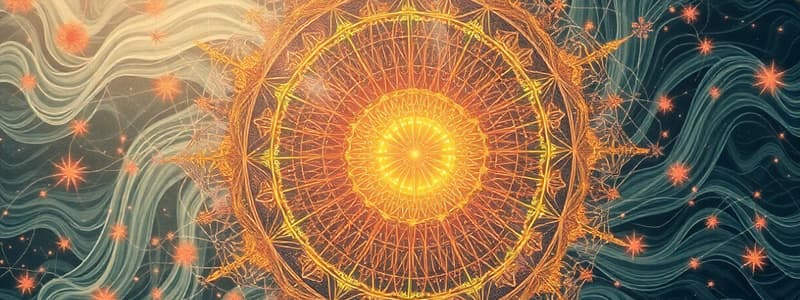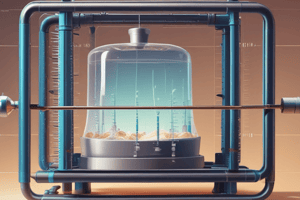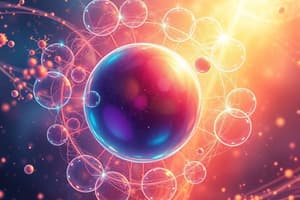Podcast
Questions and Answers
What unique property does water exhibit compared to most other solids as it cools below 4°C?
What unique property does water exhibit compared to most other solids as it cools below 4°C?
- It contracts uniformly.
- It remains unchanged.
- It expands as it cools. (correct)
- It freezes instantly.
At standard temperature and pressure (STP), what is the volume occupied by 1 mole of an ideal gas?
At standard temperature and pressure (STP), what is the volume occupied by 1 mole of an ideal gas?
- 10.0 L
- 1.00 L
- 22.4 L (correct)
- 24.5 L
Which of the following statements about the Ideal Gas Law is correct?
Which of the following statements about the Ideal Gas Law is correct?
- Volume can be in any arbitrary unit.
- Temperature must be measured in Celsius.
- Pressure must be measured in mmHg.
- Pressure must be the absolute pressure. (correct)
What is the primary outcome of collisions between gas molecules according to the kinetic theory?
What is the primary outcome of collisions between gas molecules according to the kinetic theory?
What occurs during the process of evaporation of an open container of water?
What occurs during the process of evaporation of an open container of water?
In the context of the gas laws, what is Avogadro's number primarily used for?
In the context of the gas laws, what is Avogadro's number primarily used for?
What defines thermal equilibrium in the context of the Zeroth Law of Thermodynamics?
What defines thermal equilibrium in the context of the Zeroth Law of Thermodynamics?
What happens to the average kinetic energy of gas molecules as the temperature increases?
What happens to the average kinetic energy of gas molecules as the temperature increases?
Which statement describes vapor pressure?
Which statement describes vapor pressure?
What is the relationship between temperature and saturated vapor pressure?
What is the relationship between temperature and saturated vapor pressure?
What does relative humidity measure?
What does relative humidity measure?
Which of the following statements is true about evaporation?
Which of the following statements is true about evaporation?
What happens at the triple point of a substance?
What happens at the triple point of a substance?
What is the coefficient of linear expansion primarily used to measure?
What is the coefficient of linear expansion primarily used to measure?
Which temperature scale is NOT commonly used?
Which temperature scale is NOT commonly used?
What occurs below the critical temperature of a gas?
What occurs below the critical temperature of a gas?
How is atomic mass measured?
How is atomic mass measured?
What defines diffusion in a substance?
What defines diffusion in a substance?
What does one mole of a substance represent?
What does one mole of a substance represent?
Flashcards
Thermal Equilibrium
Thermal Equilibrium
The state where two objects in contact have the same temperature and no heat flows between them.
Zeroth Law of Thermodynamics
Zeroth Law of Thermodynamics
A law stating that if two objects are in thermal equilibrium with a third object, then they are also in thermal equilibrium with each other.
Thermal Expansion
Thermal Expansion
The change in volume of a material due to a change in temperature.
Ideal Gas
Ideal Gas
Signup and view all the flashcards
Ideal Gas Law
Ideal Gas Law
Signup and view all the flashcards
Avogadro's Number
Avogadro's Number
Signup and view all the flashcards
Kinetic Theory
Kinetic Theory
Signup and view all the flashcards
Temperature
Temperature
Signup and view all the flashcards
Vapor Pressure
Vapor Pressure
Signup and view all the flashcards
Diffusion
Diffusion
Signup and view all the flashcards
Saturated Vapor Pressure
Saturated Vapor Pressure
Signup and view all the flashcards
Critical Temperature
Critical Temperature
Signup and view all the flashcards
Triple Point
Triple Point
Signup and view all the flashcards
Evaporation
Evaporation
Signup and view all the flashcards
Relative Humidity
Relative Humidity
Signup and view all the flashcards
Mole
Mole
Signup and view all the flashcards
Kinetic Energy and Temperature
Kinetic Energy and Temperature
Signup and view all the flashcards
Coefficient of Volume Expansion
Coefficient of Volume Expansion
Signup and view all the flashcards
Coefficient of Linear Expansion
Coefficient of Linear Expansion
Signup and view all the flashcards
Study Notes
Chapter 13: Temperature and Kinetic Theory
- This chapter covers the atomic theory of matter, temperature, and thermometers.
- It also discusses thermal equilibrium, the zeroth law of thermodynamics, thermal expansion, gas laws, absolute temperature and the ideal gas law.
- Additional topics include problem-solving with ideal gas laws, the kinetic theory and molecular interpretation of temperature, distribution of molecular speeds, real gases and changes of phase, vapor pressure and humidity, and diffusion.
13-1 Atomic Theory of Matter
- Atomic and molecular masses are measured in unified atomic mass units (u).
- One unified atomic mass unit (u) is equal to 1.6605 x 10⁻²⁷ kg.
- Carbon-12 has a mass of exactly 12.0000 u.
- Brownian motion is the jittery motion of tiny flecks in water, caused by collisions with individual water molecules.
- Molecules in solids, liquids, and gases have different microscopic arrangements.
13-2 Temperature and Thermometers
- Temperature measures how hot or cold something is.
- Most materials expand when heated.
- Thermometers use properties of matter that change with temperature to measure temperature.
- Common thermometers include liquid-in-glass and bimetallic strip types.
- Temperature is typically measured using the Fahrenheit or Celsius scale.
- The freezing point of water is 0°C or 32°F; the boiling point is 100°C or 212°F.
13-3 Thermal Equilibrium and the Zeroth Law of Thermodynamics
- Two objects in thermal contact eventually reach the same temperature (thermal equilibrium).
- The zeroth law states that if two objects are each in thermal equilibrium with a third object, then they are in thermal equilibrium with each other.
- Linear expansion happens when an object is heated.
13-4 Thermal Expansion
- The coefficient of linear expansion (represented by 'a') describes how much a solid expands when heated.
- Volume expansion (represented by 'β') is similar to linear expansion, but applies to liquids and gases as well as solids.
- For uniform solids, β is roughly equal to 3α.
- Water's expansion behavior is different from other substances; it has a minimum volume at 4°C.
- Thermal stress occurs when a material is fixed at its ends and cannot expand freely when the temperature changes.
13-5 The Gas Laws and Absolute Temperature
- The relationship between volume, pressure, temperature, and mass of a gas is described by an equation of state.
- Boyle's Law: The volume of a gas is inversely proportional to its pressure when temperature is constant.
- Gas volume is linearly proportional to temperature when pressure is constant.
- Extrapolating this relationship, the volume becomes zero at -273.15°C, known as absolute zero.
- Absolute (Kelvin) temperature scale starts at 0 K at absolute zero, similar to Celsius, but with different numerical values for freezing and boiling points of water. (273.15K & 373.15 K respectively).
13-6 The Ideal Gas Law
- Combining the gas laws gives the ideal gas law: PV = nRT.
- A mole (mol) is the mass of a substance (grams) equivalent to its molecular mass.
- For example, 1 mole of H₂ = 2 grams.
- The ideal gas law includes the number of moles (n) and the universal gas constant (R).
13-7 Problem Solving with the Ideal Gas Law
- Standard temperature and pressure (STP) is defined as T=273K and P=1.00atm (101.3kPa).
- The volume of 1 mole of an ideal gas at STP is about 22.4 L.
- Temperature must be measured in Kelvin when using the Ideal Gas Law.
13-8 Ideal Gas Law in Terms of Molecules: Avogadro's Number
- The universal gas constant allows for the same number of molecules to be found in 1 mole of any gas (Avogadro’s number).
- Avogadro's number is approximately 6.02 x 10²³.
- The number of molecules (N) in a gas is the number of moles (n) times Avogadro's number.
13-9 Kinetic Theory and the Molecular Interpretation of Temperature
- Kinetic theory assumptions include that gases have many molecules moving randomly at various speeds, molecules are far apart, molecules interact only when colliding, and collisions are perfectly elastic.
- The pressure of a gas is related to the average kinetic energy of its molecules and the temperature of the gas is related to the average translational kinetic energy of gas molecules.
- The average speed of molecules is related to the temperature and the molar mass of the gas.
13-10 Distribution of Molecular Speeds
- Maxwell derived graphs showing the distribution of speeds for molecules in a gas; the most probable speed isn't the same as the root-mean-square speed.
- As expected, the curves shift further along the speed axis towards higher speeds as the temperature increases.
13-11 Real Gases and Changes of Phase
- Gas behavior deviates from ideality at lower temperatures. (Further from ideal as temperature decreases)
- At lower temperatures, gases can transition to a liquid phase if pressure is high enough.
- The critical point is the highest temperature at which a gas can be liquefied.
- A phase diagram shows all three phases of matter and phase transitions like melting, freezing, boiling, condensation, and sublimation.
- The triple point shows the unique temperature and pressure at which all three phases can coexist. (Phase diagrams for water and carbon dioxide are discussed).
13-12 Vapor Pressure and Humidity
- Evaporation is the process by which the fastest molecules escape from a liquid surface. (cooling process)
- Condensation is the opposite process of evaporation.
- When evaporation and condensation are at equilibrium, the vapor is saturated, and its pressure is called the saturated vapor pressure.
- Saturated vapor pressure increases with temperature.
- Liquid boils when its saturated vapor pressure equals the external pressure.
- Partial pressure and relative humidity are defined in relation to mixtures of gases.
- Humidity describes how close or far a mixture of gases is from saturation relative to water vapor.
13-13 Diffusion
- Diffusion is the process of a substance spreading out until its concentration is uniform.
- Diffusion occurs from a high concentration region towards a region of lower concentration.
- The rate of diffusion is directly proportional to the diffusion constant (D)
Studying That Suits You
Use AI to generate personalized quizzes and flashcards to suit your learning preferences.




